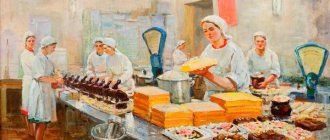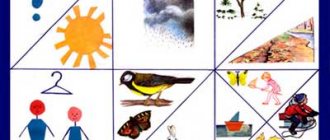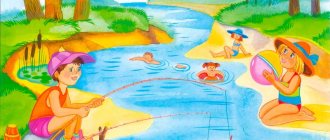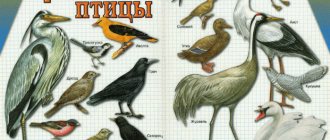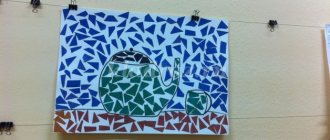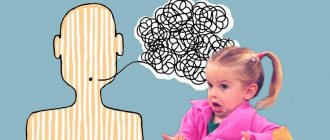MAGAZINE Preschooler.RF
A comprehensive lesson in the preparatory group on familiarization with the environment and development of speech “Russian folk art. Russian costume"Goal: To tell children about the versatility of Russian folk art. Introduce Russian folk costume. Develop memory, attention, imagination, speech. Foster respect for the creativity of your people.
Preliminary work: conversation “Russian costume. Peculiarity of appearance" , "History of costume" .
Developmental environment: Masha doll, audio recording “Oh you, canopy, my canopy” , Russian costume poster (if available), didactic material: “The world around us” , “National costumes” , publishing house “Fantasy Land” , presentation “Folk costume” , colored pencils, album.
Progress of the lesson.
Educator: Guys, what do we call Russian national costume?
Children's answer: sundress, shirt, caftan, shawl, shirt, etc.
Educator: That's right, guys. Russian national costume has been used from ancient times to the present day.
The main men's clothing is a shirt or undershirt. The men's suit throughout Russia was the same. From infancy until the “round dance” period, a shirt and belt were the only clothing. Look at the screen and notice what an ancient Russian men's suit looked like. (Slide show).
Shirts were made from linen and cotton fabrics, as well as silk. Pants are tucked into boots or onuchi with bast shoes.
On the territory of Russia, there are four sets of women's clothing - with a sundress, with a poneva (woolen skirt), with an andarak skirt, with a kubelka - a swing dress. Now let's see what the women's ancient national costume looked like. (Show slide.)
The basis of a woman's costume was a long, belted shirt. It was decorated with trim or embroidery, sometimes embroidered with pearls. Noble women had outer shirts - maids. Maids' shirts were made from bright silk fabric, often red. (Slide show).
Both men's and women's clothing were decorated with patterns - ornaments. Each element of the ornament had a specific meaning:
The sun sign meant fertility, prosperity;
The sign of water, like a wave, meant fun, joy;
The sign of a sown field is happiness, wealth, prosperity.
The ornament used mainly four colors, each of which also has a specific meaning:
Red – well-being; Yellow – warmth, affection; Blue – joy; Black is wealth.
(Slide show)
A doll in Russian folk costume comes to visit.
Masha: Hello, guys. I am Mashenka from a fairy tale. What fairy tale do you think I came to visit you from?
Children answer ( "Masha and the Bear" )
Masha: Well done, guys. You know, this fairy tale is called a folk tale because it was composed by the people. The Russian people have many wonderful fairy tales in their collection. Let's remember their names (children call them). -Well done, you know a lot of Russian folk tales. Our people are full of talents, and in addition to fairy tales, they have created a lot of beautiful and interesting things. For example, Russian folk songs. I suggest you dance to one of them.
Physical exercise. Children dance to the song “Oh, you, my canopy, my canopy .
Masha: Guys, pay attention to my suit. It was also created by our great people. -Would you like to wear such costumes?
Children's answer: Yes. Unfortunately, in our time, folk costumes are worn only by artists performing Russian folk songs and dances, playing in orchestras of Russian folk instruments, as stage costumes.
I have a complicated chest with me. Mysteries live in it and await your answers.
If you guess the riddles, he will show you the answers.
(Make riddles about Russian costume)
Every day in the morning I put on the trumpet. Well, can't you guess? She's called... (Sarafan)
It adorns the head and looks like a flower. It's all embroidered with patterns, it's really good. (Kokoshnik)
The peasant woman's headdress was chosen for themselves: To work and to walk - What should you tie?
Collected into a bundle of fabric... (Scarf)
What kind of clothes are these: With four holes. You enter at one, and you leave at three. (Shirt)
It doesn’t provide warmth, and without it it’s cold. (Belt)
(Masha takes out the clue pictures from the chest, but they crumble)
Masha: Oh, guys, while I was bringing the chest here to you.
There was a problem with my answers.
The answers scattered.
Make them quickly, guys.
(Game “Cut Pictures” . Children make up elements of Russian clothing6 sundress, kokoshnik, scarf, shirt, belt and name them).
Masha: Thank you, well done, you made me happy.
For this I will give you gifts, and you, guys, decorate them yourself. Girls have kokoshniks, and boys have belts. Get to work, friends.
(The teacher distributes kokoshniks and belts to the children, and the children decorate them with patterns at their own discretion, using the basic elements and colors of the Russian costume ornament).
| Next > |
Summary of the speech therapy lesson “Clothing and footwear” preparatory group
1st child. I want to talk about the jacket. It is beautiful, bright red, warm, waterproof. It has a blue hood and pockets. The jacket and pockets are zipped. The sleeves of the kurgka have blue cuffs. The cuffs are also zippered. The jacket has a yellow lining and yellow reflective stripes on the sleeves. This jacket is worn in autumn in damp, cold weather.
2nd child. And I'll tell you about the trousers. They are blue, warm, waterproof. They fasten with a zipper. They have pockets. The pockets are also zippered.
3rd child. I will talk about the hat. It is yellow, waterproof, warm. The cap has long ears with a Velcro fastener and a visor. The lining of the cap is red. This hat can be worn on a damp, cold autumn day.
4th child. And I'll tell you about the boots. They are rubbery, yellow, warm. They have red soles and red heels. They are also decorated with red fur trim. They are worn in damp, cold weather in the fall.
The speech therapist places the plane and the mother 's lesion on the carpet in front of the children.
Speech therapist. Help Seryozha get ready for a walk. Dress him up.
Fly with the help of Velcro, which are glued to the base and fix the images of clothes on the boy. The speech therapist also attaches a planar image of a checkered red-blue-wrinkled scarf.
4. Exercise “Choose a diagram.” (Improving the skills of sound analysis and word synthesis.|
The speech therapist places the sound diagram of the word on the carpet.
Rice. 53
Speech therapist. Look carefully at Seryozha and at the word diagram. Which item of clothing does this pattern match the name of?
Children. The diagram matches the word scarf,
because this word has four sounds. The first, third and fourth sounds are hard consonants, and the second sound is a vowel.
Speech therapist. Say the fourth sound. Masha, and tell us about him.
1st child. |F|. This is a consonant, solid, dull sound.
Next, the speech therapist invites the other children to pronounce one sound from a given word and talk about them.
5. Outdoor game “Boots”. [Coordination of speech with movement.) (Repetition. See lesson 1. Topic “Clothes, shoes, hats.”)
The speech therapist invites the children to go to the carpet and do a familiar exercise.
6. Dominoes “Clothes, shoes, hats.” (Development of phonemic representations. Automation of correct pronunciation and differentiation of sonorous sounds in gaming activities]
The speech therapist invites the children to sit on the carpet and lays out cards for playing dominoes in front of them, on which the following items are depicted: jacket - beret, blouse - hat, felt boots - shirt, panties - shorts, breeches - scarf, T-shirt - sundress, sneakers - Spanish, sweater - tuff! And. The speech therapist shuffles the cards and distributes them to the children two at a time.
